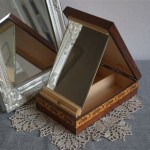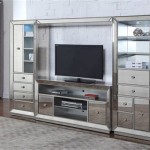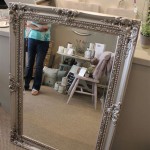How to Put a Frame Around an Existing Bathroom Mirror
Many bathrooms feature mirrors that are simply glued to the wall. While functional, these mirrors often lack character and can appear quite plain. Adding a frame is a relatively straightforward and cost-effective way to enhance the aesthetic appeal of a bathroom mirror, providing a finished and polished look that complements the overall design of the space. This article provides a comprehensive guide on how to frame an existing bathroom mirror, covering preparation, material selection, installation, and finishing touches.
Preparation and Planning: Ensuring a Successful Framing Project
Prior to commencing the framing process, thorough preparation and planning are essential. This stage involves accurate measurement, material selection that aligns with the bathroom's decor, and the gathering of necessary tools and safety equipment. This careful planning will minimize errors and ensure a smoother, more efficient installation.
The first step is to accurately measure the mirror. Measure the height and width of the visible mirror surface. These dimensions will be crucial in determining the overall size of the frame and the amount of material required. Ensure the measurements are precise to avoid gaps or overlaps during installation. Add the desired width of the frame to each side of the mirror measurement. For example, if the mirror measures 30 inches wide by 40 inches high, and a 2-inch wide frame is planned, the total dimensions of the frame would be 34 inches wide by 44 inches high.
Selecting the appropriate framing material is a crucial decision. Wood is a popular choice due to its versatility and aesthetic appeal. Options include pine, oak, and poplar. Consider the moisture levels in the bathroom when selecting wood; hardwoods are generally more resistant to moisture than softwoods. PVC trim board is an excellent alternative to wood, as it is waterproof and resistant to warping or rotting. It is also lightweight and easy to work with. Metal frames are another option, offering a sleek and modern look. Aluminum and stainless steel are common choices for metal frames, providing durability and resistance to corrosion.
The style of the frame should complement the existing bathroom decor. For a traditional bathroom, consider a frame with ornate details or a rich wood finish. A modern bathroom may benefit from a simple, clean-lined frame with a minimalist design. Consider the color scheme of the bathroom and choose a frame finish that either matches or complements the existing colors. Paint, stain, and metallic finishes are all viable options, depending on the chosen framing material and desired aesthetic.
Before beginning the project, gather all the necessary tools and materials. Essential tools include a measuring tape, miter saw or miter box and hand saw, safety glasses, pencil, construction adhesive or mirror mastic, caulk gun, painter's tape, sandpaper, wood filler (if using wood), paint or stain, paintbrushes or staining cloths, and a level. It’s also helpful to have a damp cloth to wipe away excess adhesive or caulk.
Frame Construction and Mounting
After the preparation phase, the next step involves constructing the frame and mounting it to the mirror. This requires precise cutting and joining of the frame pieces, followed by secure attachment to the mirror surface using appropriate adhesives and support methods.
Cut the frame pieces to the dimensions calculated earlier. If using a miter saw, set the blade to a 45-degree angle for creating mitered corners. Mitered corners offer a clean and professional look. Alternatively, a miter box and hand saw can be used for creating accurate angles. Ensure each piece is cut precisely to avoid gaps or uneven edges. For butt joints, where the frame pieces meet at a 90-degree angle, simply cut the pieces to the correct length using a straight cut.
Assemble the frame pieces on a flat surface. If using wood, apply wood glue to the mitered or butt joints and clamp the pieces together until the glue dries. Use corner clamps to ensure the corners are square and aligned. Alternatively, use a brad nailer to secure the joints while the glue dries. For PVC trim board, use PVC cement to join the pieces together. Metal frames may require welding or the use of corner brackets for assembly. Allow the adhesive or fasteners to fully cure before proceeding to the next step.
Once the frame is assembled, prepare it for mounting. If using wood, fill any nail holes or imperfections with wood filler. Allow the filler to dry and then sand the entire frame smooth with fine-grit sandpaper. Apply a primer to the frame for better paint adhesion. If using PVC or metal, clean the surface with a suitable cleaner to remove any dirt or grease. Paint or stain the frame to the desired color and finish. Apply multiple thin coats for a more even and durable finish. Allow each coat to dry completely before applying the next.
Apply construction adhesive or mirror mastic to the back of the frame. Apply the adhesive in a continuous bead around the inside edge of the frame, close to the mirror. Also, apply several beads of adhesive across the back of the frame for added support. Use a caulk gun for precise and controlled application. Press the frame firmly onto the mirror, ensuring it is centered and aligned correctly. Use painter's tape to hold the frame in place while the adhesive dries. Apply strips of tape across the frame and onto the surrounding wall to provide temporary support. Depending on the weight of the frame and the manufacturer's instructions for the adhesive, it may be necessary to support the frame with additional bracing while the adhesive cures fully. Allow the adhesive to cure for at least 24 hours, or as specified by the adhesive manufacturer.
Finishing Touches and Considerations
After the frame is securely mounted, the final stage involves completing the finishing touches and addressing any potential issues, ensuring a polished and professional final product. This may include caulking the edges, cleaning the mirror, and addressing any gaps or imperfections.
Once the adhesive has fully cured, remove the painter's tape. Inspect the frame for any gaps or imperfections. Apply a bead of caulk around the inside and outside edges of the frame where it meets the mirror and the wall. Use a caulk gun to apply the caulk in a smooth, even line. Immediately after applying the caulk, smooth it with a wet finger or a caulking tool. This will create a clean and professional seal. Wipe away any excess caulk with a damp cloth.
Clean the mirror thoroughly to remove any fingerprints, smudges, or adhesive residue. Use a glass cleaner and a lint-free cloth for best results. Polish the mirror until it is sparkling clean. Inspect the finished frame for any imperfections or areas that may require touch-ups. Touch up any paint or stain as needed. If any gaps or cracks are visible, fill them with caulk or wood filler and repaint or restain the area.
Consider the overall appearance of the framed mirror and how it integrates with the rest of the bathroom decor. If desired, add decorative elements such as decorative corners or embellishments to further enhance the frame's aesthetic appeal. Ensure the lighting in the bathroom is sufficient to highlight the framed mirror. Consider adding additional lighting fixtures above or beside the mirror to improve visibility and create a more inviting atmosphere.
Addressing safety concerns is paramount. When cutting materials, always wear safety glasses to protect the eyes from flying debris. Use caution when handling sharp tools and adhesives. Ensure the adhesive is suitable for use with mirrors and that it will not damage the mirror's backing. If the mirror is large or heavy, consider seeking assistance from another person to ensure it is safely mounted. Before starting any work, turn off the power to any electrical outlets or fixtures near the mirror to avoid the risk of electric shock.
Adding a frame to an existing bathroom mirror is a relatively simple project that can significantly enhance the aesthetic appeal of the bathroom. By following these steps and taking the necessary precautions, anyone can achieve a professional-looking framed mirror that complements the overall design of the space. Careful planning, precise execution, and attention to detail are the keys to a successful framing project.

How To Frame Out That Builder Basic Bathroom Mirror For 20 Or Less

Easy Diy Tutorial Adding Trim Around A Giant Mirror For Ers

How To Frame A Mirror

Mirror Frame Diy How To Update A Basic Bathroom Our Faux Farmhouse

Diy Stick On Mirror Frame Sawdust Sisters

The Kids Bathroom Mirror Gets Framed House Of Hepworths

How To Frame Out That Builder Basic Bathroom Mirror For 20 Or Less

How To Frame A Bathroom Mirror Lowe S

Mirror Frame Diy How To Update A Basic Bathroom Our Faux Farmhouse

Mirror Stuck On The Wall Add A Frame To An Plate Glass In Minutes T Kits Large Bathroom Mirrors Diy








